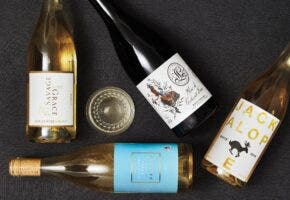What is Cabernet Franc
Pronunciation: Cab-er-nay FRAHNK
Cabernet Franc is a red-wine grape variety traditionally grown in France that makes medium- to full-bodied wines typically offering red-fruit flavors and complex herbaceous accents. The grape is a significant component in some of the world’s greatest and most sought-after wines, particularly Bordeaux blends, like Château Cheval Blanc and Château Ausone, and classic red wines in the Loire Valley, too.
Cabernet Franc grapes are used primarily for dry red wines but also for rosé and sometimes sparkling wines in a few parts of the world.
The grapes grow in small to medium-size clusters on vines that tend to be vigorous and can provide large yields. The Cabernet Franc grapes develop a blue-black color late in the growing season. The leaves usually have five lobes and show sharp “teeth” between the lobes.
A Cabernet Franc grapevine looks similar to that of Cabernet Sauvignon, which is a genetic offspring of Cabernet Franc, and to that of Merlot.
Cabernet Franc Synonyms
Cabernet Franc can sometimes be known as: Bordo, Bregon, Bouchy, Bouchet, Grow Bouchet, Cabernet Frank, Carmenet, Grosse Vidure, Messanges Rouge, Véron or Noir dur.
Cabernet Franc Regions
Cabernet Franc often is used to produce varietal wines, of which there are stunning examples made around the world, including California, Washington, New York, Italy and Canada, among others.
Cabernet Franc as a varietal wine is especially popular and traditional in the Loire Valley of France. Producers there have been working with the grape since the 11th century, mainly in the Chinon, Bourgueil, Saint-Nicolas-de-Bourgueil, Saumur, Saumur-Champigny, Anjou and Anjou-Villages appellations.
In the Medoc district of Bordeaux, Cabernet Franc is usually a minor player in a producer’s blend, along with Merlot and sometimes Petit Verdot and Malbec. In the Pomerol and St.-Emilion districts, however, Cabernet Franc is more prominent, the most famous example being at famous first-growth Château Cheval Blanc.
Cabernet Franc Tasting Notes
In relatively cool regions like the Loire Valley, Cabernet Franc wines are generally quite aromatic, with notes of red berry and cherry, as well as varying degrees of charming herbal, floral, pepper and cigar spice notes.
In Bordeaux and other warm regions globally, Cabernet Franc wines can show almost-sweet dark plum and lush blueberry flavors, herbaceous and tobacco nuances, along with firm tannins. In these warmer climates Cabernet Franc wines taste riper, richer and have fuller bodies. However, Cabernet Franc in general tends to be lighter in tannins and color than Cabernet Sauvignon.
Cabernet Franc grapes are found in red, rose, sparkling, white, and dessert wines.
Structural Characteristics
Examples of Cabernet Franc to Try
Pairs Well With
Handling Tips
Fun Facts
- It wasn’t until 1997 that Cabernet Franc was proven to be a parent grape variety, along with Sauvignon Blanc, of Cabernet Sauvignon. Researchers at the University of California, Davis, used DNA fingerprinting techniques to confirm what the grape varieties’ names long hinted at.
- Cabernet Franc is used in France to make the lightly sweet rosé wines called Cabernets d’Anjou.
- When Cabernet Franc vines were planted in northern Italy in the 19th century, the Italians at first erroneously called the vines Merlot.














